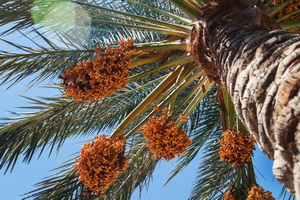
Scientists Evaluate the Use of CRISPR-Cas9 on Date Palm
November 22, 2017| |
 Various GE techniques such as CRISPR-Cas9 have been successfully employed for various crop plants including fruit trees. CRISPR-Cas9 holds great potential in GE due to their simplicity, competency, and versatility over other GE techniques. However, no such genetic improvement has been developed in date palm, an important fruit crop in Oasis agriculture.
Various GE techniques such as CRISPR-Cas9 have been successfully employed for various crop plants including fruit trees. CRISPR-Cas9 holds great potential in GE due to their simplicity, competency, and versatility over other GE techniques. However, no such genetic improvement has been developed in date palm, an important fruit crop in Oasis agriculture.
The availability of the date palm full genome sequence opened up a new door for improvement of date palm through GE and genetic manipulation. High salinity, extreme drought regimes, and blazing heat are major abiotic stresses affecting date palm. Moreover, biotic stresses are also a major worry for date palm. Developing a high yielding, resistant and good fruit quality cultivar is imperative but demands a stringent, comprehensive and reliable methodology.
However, several factors should be taken into account to fully apply CRISPR to date palm breeding. This includes designing the sgRNA to prevent off-target mutations as well as the CRISPR-Cas9 cassette delivery method into date palm cells, both of which are highly significant for the program to be successful. Date palm also has some genetic characteristics that may affect the applicability of CRISPR-Cas9, such as its outcrossing nature. This phenomenon brings high allelic heterozygosity, polymorphism, and thus, genetic instability to date palm.
The future application of CRISPR-Cas9 in date palm will not only address the basic biological questions but will definitely reduce the concerns of common people due to its non-GM nature.
For more on this review, read the full article in Frontiers in Plant Science.
| |
Biotech Updates is a weekly newsletter of ISAAA, a not-for-profit organization. It is distributed for free to over 22,000 subscribers worldwide to inform them about the key developments in biosciences, especially in biotechnology. Your support will help us in our mission to feed the world with knowledge. You can help by donating as little as $10.
-
See more articles:
-
News from Around the World
- International Food Biotechnology and Biosafety Workshop Releases Final Declaration
- Nigeria Stakeholders Embrace Bt Cotton as a Solution for Revamping the Textile Industry
- Researchers Identify Gene that Enables Wheat Resistance to Stem Rust
- Australian OGTR Releases Report on 2017 Study of Public Attitudes about GMOs, Gene Technology and its Regulation
- Senior High School Students and Teachers Take Part in Agri-biotech Boot Camp
- The Biotechnology and Bioeconomy Landscape in Malaysia
- QUT Grows World's First Panama Disease-Resistant Bananas
- Food Evolution Enlightens Filipino Students and Stakeholders on Global GMO Discussion
- EFSA Says Yes to Reauthorization for GM Sugar Beet in the EU
-
Research Highlights
- microRNA159 Impacts Multiple Agronomic Traits in Rice
- Tomato Immune Receptor Ve1 Confers Ave1-dependent Verticillium Resistance in Tobacco and Cotton
-
Beyond Crop Biotech
- Mosquitoes that Self Destruct
- Burkinabe GM Mosquito Malaria Eradication Project Gets off to a Good Start
-
Announcements
- 2017 Conservation Tillage Conference
-
Plant
- Scientists Evaluate the Use of CRISPR-Cas9 on Date Palm
-
Read the latest: - Biotech Updates (April 17, 2024)
- Gene Editing Supplement (April 10, 2024)
- Gene Drive Supplement (February 22, 2023)
-
Subscribe to BU: - Share
- Tweet
